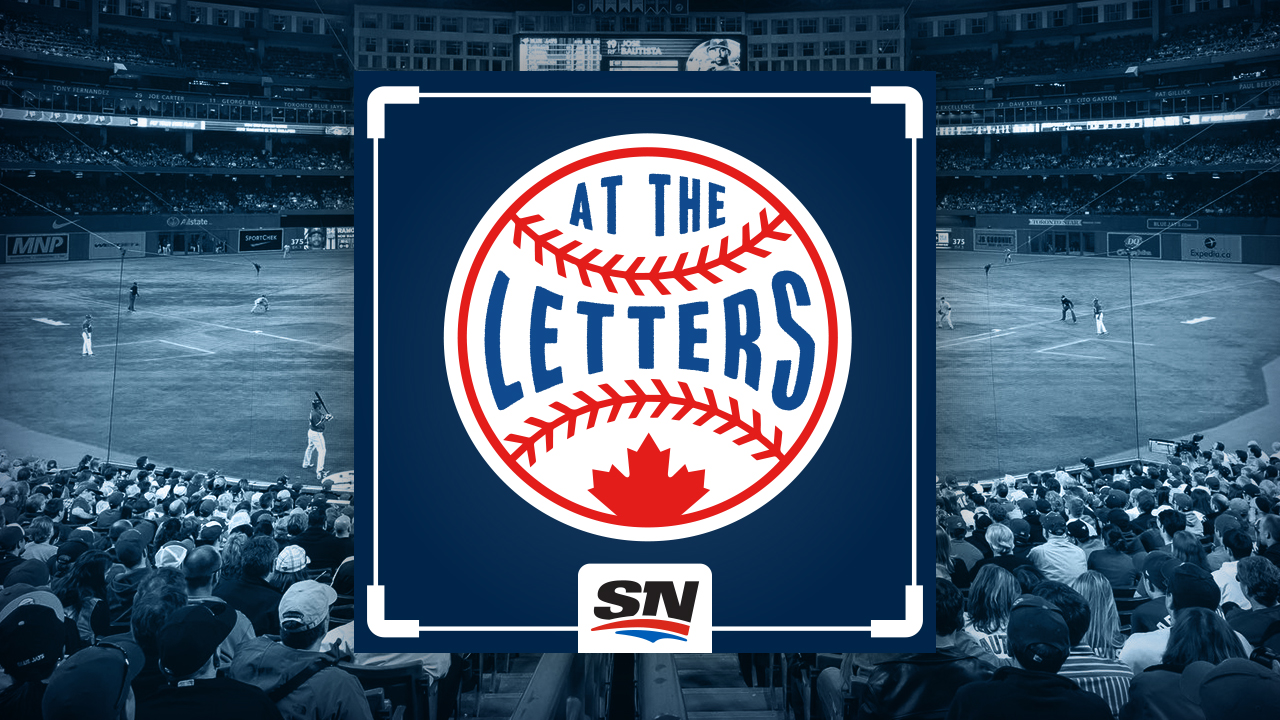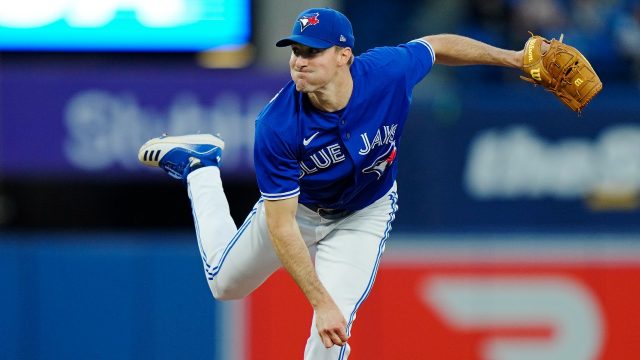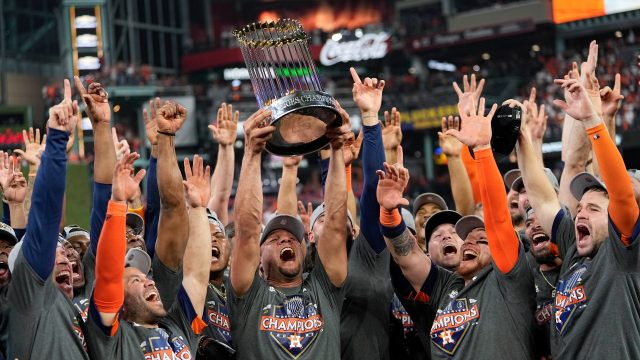
Let’s begin our discussion of the Toronto Blue Jays as they enter the off-season with a couple of questions for you, valued readers: How transformative a winter do you want the team to have, and how much reframing of the roster does the club actually need?
General manager Ross Atkins and the rest of the front office have been mulling precisely that ever since the gutting Game 2 loss to the Seattle Mariners in early October, and the answers, at least from this vantage point, aren’t obvious on either front.
With only three free agents — Ross Stripling, Jackie Bradley Jr. and David Phelps — the Blue Jays can essentially run it back with a group that finished 92-70 and claimed the top wild-card spot in the American League.
Considering the majority of their players are still trending toward performance peaks, rather than being at or past them, that’s a pretty enviable starting point. They could easily be better, maybe even much better, in 2023 simply through internal improvement alone.
At the same time, complacency is the enemy of progress. And though the Blue Jays have the foundation to be a consistent post-season club, they can’t bury their heads to what’s happened to them over the past couple of years, and where they stand in relation to the truly elite teams, like the freshly crowned World Series champion Houston Astros.
Remember in 2021, the Blue Jays muddled their way through the first four months of the season before taking off upon returning home to Toronto, finishing on a 40-23 run that left them one agonizing game short of the playoffs. This past season, haunted again by bouts of loose play that also undermined them the year before, they opened 46-42 under Charlie Montoyo before finishing 46-28 under John Schneider.
Now, given the authority of a three-year contract and a full spring to establish expectations and norms, the ship should be run much tighter under Schneider, who drew praise for addressing issues immediately and a willingness to initiate difficult conversations with players.
There should be a net gain there.
Still, the loss to the Mariners, even if just a two-game sample prone to randomness, and a broader look at what played throughout the playoffs, offer glimpses into where their areas of opportunity lie.
When the Blue Jays needed swing-and-miss relief work from their bullpen during the Game 2 implosion, for instance, they didn’t have enough relievers to miss bats. That proved costly when the Mariners, who deserve credit for pesky at-bats, made enough contact to find soft spots that a tighter defence might have swallowed up. On at least a couple of balls, that might have been enough margin to deflate rallies.
Regardless, the Astros, who have appeared in six straight American League Championship Series with four World Series berths, are standard-bearers in both regards.
Their relief work this fall was a Tour de Force, powered by closer Ryan Pressly, Bryan Abreu, Rafael Montero and Hector Neris, and is the obvious ideal for any club. Several plus defenders back both them and a strong rotation, while providing a batting order that’s both fearsome and diverse. There’s the high-contact, total-plate coverage of Jose Altuve and Yuli Gurriel, the opportunistic table-setting of Jeremy Pena, the Darth-Vaderesque might of Yordan Alvarez and the high-IQ production of Alex Bregman and Kyle Tucker.
They’re the game’s toughest Boss Monster for good reason.
The Blue Jays, who went 4-2 against the Astros during a couple of April series, actually stack up reasonably well, with a lineup that features George Springer, Vladimir Guerrero Jr., Bo Bichette, Teoscar Hernandez, Alejandro Kirk and Matt Chapman, a rotation fronted by Alek Manoah, Kevin Gausman and Jose Berrios and Jordan Romano as closer.
But gaps lie in the bullpen, defensively and in lineup balance, in terms of both handedness and type of hitter.
And it’s that separation in subtleties that beg the questions we started with and make the next steps somewhat tricky.
So, as the baseball industry gathers in Las Vegas this week for the general managers’ meetings, some factors to consider:
ROSTER NEEDS
The obvious place to begin is in the rotation, where Stripling must be replaced if he isn’t re-signed and another starter is needed with the Blue Jays not depending on Yusei Kikuchi or Mitch White to take a spot and run with it.
Fortifying the bullpen in front of Romano and primary set-up man Yimi Garcia is similarly essential but difficult to do, with the $102-million, five-year extension Edwin Diaz agreed to with the New York Mets underlining the inherent expense of top-flight help.
In an ideal world, the Blue Jays also add a plus defensive centre-fielder who bats either left-handed or switch hits, allowing Springer to slide into right field, fortifying the majority of the outfield. Such an add would likely push out either Hernandez or Lourdes Gurriel Jr., making that more of a transformative possibility.
FINANCIAL PICTURE
The Blue Jays finished the season with a franchise-high payroll of roughly $175 million for the 26-man roster and without doing anything are due to surpass that in 2023.
Once the $3 million option on Anthony Bass is officially exercised, they’ll have about $120 million committed to 10 players. Next, their 13 arbitration-eligible players, who earned some $34.7 million in 2022, are projected to jump to the area of $62 million, according to MLB Trade Rumors. Once you factor in salaries for pre-arbitration players, the Blue Jays are pushing toward $190 million.
How far beyond that they can push is unknown but the initial sense is that for the Blue Jays to make another big-money signing, they’ll need to move some money off the roster. They could free up dollars by non-tendering some of their arbitration-eligible players by the Nov. 18 deadline, but improving on them within tight confines won’t be easy — a significant factor in how transformative this winter can be.
RYU’S HIT
While the Blue Jays have to manage against those potentially tight confines right now, they should be able to weaponize their financial flexibility next fall. Between Hyun Jin Ryu, Hernandez, Chapman and Gurriel, more than $50 million will come off the books after the 2023 season and while they’ll need to be re-signed or replaced, there’ll be significant opportunities there.
One reason for that is Ryu’s $20 million hit next year will be mostly empty calories as he recovers from Tommy John surgery, which he underwent in mid-June. Now, whether the Blue Jays will recoup some or all of that money is unclear, as Atkins was vague when asked if the deal was insured. But that he left the possibility open is reason to think they have some sort of coverage.
“Every player is different and we definitely are using that resource in the organization,” he said after the season, “but don’t want to talk about individuals that may or may not have that.”
ROSTER JUGGLING
Teams must set their 40-man rosters by Nov. 15 and that means both protecting prospects eligible for selection in the Rule 5 draft and reinstating players from the 60-day injured list. Ryu is on the 60 and whether he’s worth carrying on the 40 all winter long for the potential of a few late-season outings is worth debating.
As Atkins noted at the end of the season, a return in “the absolute best-case scenario is in that 12-13 month range, which would be a little bit past the halfway point (of the ’23 campaign). More realistically it would probably be a little bit behind that.”
Prospects eligible for the Rule 5 draft include Orelvis Martinez, Yosver Zulueta, Addison Barger, Gabriel Martinez, Adrian Hernandez and Spencer Horwitz while Vinny Capra is also on the 60-day IL.
TRADE FODDER
The Blue Jays eased some of their 40-man pressure at the trade deadline when they dealt Jordan Groshans, Max Castillo and Samad Taylor and perhaps they do some more housekeeping along those lines before Nov. 18. Regardless, many of the factors above may drive them to be more active on the trade front, especially if they conclude they need change on the big-league roster.
Their farm system, restocked this past summer with the help of two compensatory draft picks, may still be a bit thin to make splashy present-for-future deals, but they can certainly make some things happen off of their big-league roster.
The most obvious surplus area for the Blue Jays is behind the plate, where they have all-star Kirk, the veteran Danny Jansen and the up-and-coming Gabriel Moreno. Using one of them to land a centre-fielder or starting pitcher who is young and contractually controllable for an extended period makes perfect sense for the club.
Trading from the outfield is another possibility, both to free up some money and change skill-sets.
THE BOTTOM LINE
Change for the sake of change makes little sense, especially if it erodes talent. The challenge for the Blue Jays, should they choose the transformative route, is in getting more left-handed at the plate and acquiring different types of hitters with players commensurate to those they have now.
This is, of course, the time to explore various ideas and kick around all kinds of scenarios, from obvious to outlandish, which is why they’ll check in on virtually every free agent and discuss trade possibilities with all clubs.
But 92 wins in the uber-competitive AL East is an already high bar to clear and tweaking to not only get back to the post-season but to also win there is even harder.







